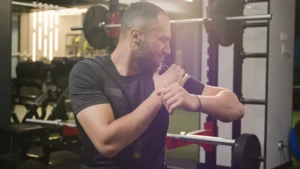Shoulder instability arises when the shoulder joint becomes too loose, often leading to discomfort and reduced mobility. This can occur due to a range of factors, including traumatic injuries, repeated overuse, genetic predispositions, or underlying conditions that affect the shoulder’s supportive structures. In this article, we will explore what causes shoulder instability in depth, providing insights into how it happens and what you can do to manage or prevent it.
Key Takeaways
- Shoulder instability is typically caused by trauma or injury leading to stretched, torn, or detached tissues within the shoulder, but genetic factors and congenital laxity also play a role.
- Symptoms of shoulder instability include pain, decreased range of motion, and a sensation of the shoulder ‘giving out’. Diagnosis is achieved through physical exams and imaging tests, and treatment involves both nonsurgical methods and, if necessary, surgery.
- Preventing shoulder instability relies on strengthening exercises and avoiding activities that stress the shoulder, while living with the condition includes lifestyle modifications and adhering to treatment plans for symptom management.
Understanding Shoulder Instability
Shoulder instability is a condition characterized by the loss of shoulder joint stability. Shoulder instability occurs when the lining of the shoulder joint, ligaments, or labrum become stretched, torn, or detached. The shoulder’s structures might not heal properly after an injury, increasing the risk of future subluxation or dislocation. But what causes these structures to become compromised in the first place?
To answer this question, let’s take a closer look at three potential culprits: shoulder dislocation and subluxation, labral tears, and genetic factors. These elements contribute to the complexity of shoulder instability and understanding them will provide a deeper insight into this condition.
Shoulder Dislocation and Subluxation
A shoulder subluxation occurs when the shoulder head partially slides out of the socket, while dislocation involves full detachment of the humeral head from the joint. Often, an initial shoulder dislocation is caused by severe injury or trauma, especially in athletes who frequently reach overhead or out to the side.
But it’s not just trauma that can cause these issues. Athletes with congenital laxity of tissues, for instance, may experience multidirectional shoulder instability and dislocations without a specific traumatic event. Moreover, repeated subluxation can lead to a loosening of ligaments, cartilage, and muscles around the shoulder joint, exacerbating its instability.
Labral Tear
The labrum, a cartilage rim around the edge of the glenoid, plays a crucial role in stabilizing the shoulder joint. When the labrum tears or detaches from the glenoid, it can destabilize the shoulder. These tears often result from acute trauma or repetitive shoulder movements.
A labral tear is a common cause for the shoulder to become unstable, often necessitating medical intervention. This condition illustrates how both a sudden injury and chronic wear and tear can contribute to shoulder instability.
Genetic Factors
While injuries and wear and tear can induce shoulder instability, some individuals are genetically predisposed to this condition. These individuals may be born with looser shoulder ligaments, leading to an inherent risk for shoulder instability. Certain genetic conditions contribute to the presence of looser ligaments, making shoulders more susceptible to instability.
The role of genetics in shoulder instability underscores the fact that this condition can be complex and multifactorial. It’s not simply a matter of injury or overuse – one’s genetic makeup can also play a significant role.
Common Causes of Shoulder Instability
Now that we’ve delved into the anatomy and potential causes of shoulder instability, let’s turn our attention to some common triggers. While injuries are the most common cause of shoulder instability, labral tears resulting from shoulder dislocation, trauma, or repetitive motion also contribute significantly to this condition. Additionally, chronic shoulder instability can arise from torn or stretched ligaments, cartilage damage, and muscle weakness or tears.
However, not all causes of shoulder instability are created equal. Some people are more prone to this condition due to certain activities or conditions. These include sports injuries, overuse and repetitive motion, and a condition known as hyperlaxity. Let’s take a closer look at each of these factors.
Sports Injuries
Certain sports can contribute significantly to shoulder instability. Repetitive overhead activities, for instance, are a major contributor due to the resulting wear and tear on the shoulder’s muscles and ligaments. Sports that involve frequent throwing or striking, such as volleyball and baseball, can cause a gradual weakening of the shoulder’s passive tissues, contributing to shoulder instability.
Overuse of shoulder muscles and ligaments through sports activities, such as throwing a ball or hitting hard, can also lead to shoulder instability. Athletes, therefore, need to be particularly mindful of maintaining shoulder health and seeking prompt treatment for any shoulder injuries.
Overuse and Repetitive Motion
Apart from sports injuries, repetitive overhead motions can also increase the risk of developing shoulder instability. These actions can weaken the passive tissues around the shoulder joint, particularly in athletes who regularly engage in such movements.
Movements such as throwing a baseball involve repetitive overhead motions that can lead to excessive extension of the arm behind the body, thereby contributing to shoulder instability. Over time, these repetitive motions can chronically loosen the shoulder capsule, a significant factor in the development of shoulder instability.
Hyperlaxity
Hyperlaxity refers to increased looseness in the ligaments of the shoulders, which can result in difficulty maintaining shoulder stability. Individuals with hyperlaxity are prone to chronic shoulder instability without a preceding injury, leading to an increased risk of recurrent subluxation.
Hyperlaxity may cause instability in multiple anatomic planes of the shoulder and is not necessarily associated with lesions that are common in trauma-induced instability. Overhead activities like throwing can overextend the shoulder, which, combined with hyperlaxity, further contributes to shoulder capsule looseness and instability.
Symptoms of an Unstable Shoulder
Recognizing the symptoms of shoulder instability is an essential step in seeking appropriate treatment. Individuals with shoulder instability may experience pain during certain movements or when the shoulder is in specific positions. Moreover, a decrease in the range of motion can be a symptom of shoulder instability.
In addition to pain and restricted movement, shoulder instability can lead to a sensation of the shoulder ‘giving out’ or experiencing subluxations. Individuals may also feel weakness, particularly during physical activities. These symptoms can be more pronounced if the shoulder structures, such as the capsule, ligaments, or labrum, don’t heal properly after a subluxation or dislocation, leading to a greater chance of future instability.
Diagnosing Shoulder Instability
If you’re experiencing symptoms of shoulder instability, it’s crucial to seek a diagnosis from a healthcare provider. The initial step in diagnosing shoulder instability is a physical exam performed by a doctor, which may include testing for general looseness in the ligaments. Additionally, imaging tests such as X-rays and MRI scans are instrumental in diagnosing shoulder instability after a physical examination.
Doctors also consider the patient’s history of shoulder issues and injuries to ascertain the nature of the instability, including the mechanism of injury, the arm’s position during the incident, and any subsequent episodes of instability or treatment. Let’s explore the diagnostic process in more detail, particularly how shoulder instability diagnosed plays a role in determining the appropriate course of action.
Physical Examination
The physical examination is a crucial element in identifying shoulder instability. During the exam, doctors assess for weakness, range of motion, and looseness in the shoulder. This hands-on approach allows healthcare providers to directly evaluate the stability of the shoulder joint and identify any abnormalities that could signal instability.
Imaging Tests
Imaging tests, such as X-rays and MRI scans, provide a more detailed look at the shoulder joint and upper arm bone, enhancing the diagnosis process. The glenohumeral joint, which connects the shoulder blade to the arm bone, is typically imaged using three standardized views: the anteroposterior view in the plane of the scapula, the scapular lateral view, and the axillary view.
These views offer a thorough understanding and accurate diagnosis of shoulder instability. They allow doctors to visualize any structural abnormalities or injuries that could contribute to the instability, guiding the subsequent treatment plan.
Treatment Options for Shoulder Instability
Once shoulder instability is diagnosed, a tailored treatment plan can be developed. Treatment options encompass a variety of nonsurgical methods as well as surgery, which are considered shoulder instability treatments. Nonsurgical treatments often form the first approach in managing shoulder instability, which may include:
- Rest
- Immobilization with a sling or shoulder bracing
- Range of motion and strengthening exercises
- Cold packs
- NSAIDs
However, if nonsurgical treatments aren’t sufficient, surgical options may be considered. These include Bankart repair, arthroscopy, and open repair. Let’s delve deeper into these treatment options.
Nonsurgical Treatments
Physical therapy forms the backbone of nonsurgical treatment for shoulder instability. It focuses on rebuilding muscle strength, improving flexibility, and enhancing the range of motion. Therapeutic exercises, guided by a physical therapist, can create an internal support structure for the shoulder joint by reinforcing surrounding muscles.
Non-steroidal anti-inflammatory drugs (NSAIDs) are commonly utilized to alleviate the pain and inflammation associated with shoulder instability. Applying ice packs to the shoulder for 15 to 20 minutes three times a day can reduce swelling and provide pain relief. Additionally, modifying activities to avoid aggravating the shoulder can be a key strategy in the nonsurgical management of shoulder instability.
Surgical Treatments
If nonsurgical treatments don’t provide sufficient relief, surgical intervention may be necessary. Surgical options for treating shoulder instability include Bankart repair, arthroscopy, and open repair. Arthroscopy and open surgery are used to repair torn ligaments in the shoulder, contributing to its stability.
Arthroscopy, a minimally invasive procedure, uses a tiny camera and special instruments and is usually done on an outpatient basis. The Bankart repair, which reconstructs the ligament and reattaches the labrum to the shoulder socket, has a success rate of approximately 97%.
Preventing Shoulder Instability
Prevention is always better than cure, and it’s no different when it comes to shoulder instability. Exercises that enhance the stability of the shoulder joint, such as push-ups and joint stability challenges, are effective in training the joint to minimize injury risks. Specific exercises like Side Lying External Rotation, Counter Half Push-Up, and Bent Over Row can aid in preventing shoulder instability.
Enhancing the strength of muscles that stabilize the shoulder through specific exercises can rehabilitate and minimize the risk of injury or re-injury. This proactive approach to shoulder health can help keep shoulder instability at bay, allowing you to maintain an active lifestyle.
Living with Shoulder Instability
Living with shoulder instability can be challenging, but it’s certainly manageable. Modifications in daily activities are often necessary to prevent aggravating the condition. Avoiding activities that stress the shoulder can prevent pain or further injury.
Following a comprehensive treatment plan, given to you by your orthopedic shoulder surgeon, is key to effectively manage shoulder instability symptoms. This includes adhering to prescribed physical therapy regimens, taking prescribed medications, and modifying activities as needed. With the right approach and commitment, it’s entirely possible to lead an active, fulfilling life despite shoulder instability.
Summary
Navigating the world of shoulder instability can be complex, but armed with the right knowledge, you’re well-equipped to face this challenge. We’ve journeyed through the intricate anatomy of the shoulder, explored common causes and symptoms of shoulder instability, examined diagnostic procedures, and discussed a variety of treatment options.
Remember, shoulder instability doesn’t have to dictate your lifestyle. By understanding the condition, recognizing symptoms early, and adhering to a tailored treatment plan, you can effectively manage shoulder instability and maintain a high quality of life. Arm yourself with knowledge, take control, and keep moving forward!
Frequently Asked Questions
What are the factors affecting shoulder stability?
Shoulder stability is affected by a combination of factors including the relationship between the humeral head and the scapula, the integrity of bony structures and soft tissues, and the neuromuscular balance of surrounding muscles. These factors collectively contribute to the overall stability of the shoulder joint.
How do you fix shoulder instability?
You can fix shoulder instability with a Bankart repair, which reattaches the torn capsule to the glenoid rim by making three holes in the glenoid rim. This process involves separating the muscles to expose the shoulder capsule and is an effective way to address the issue.
What is shoulder instability?
Shoulder instability is a condition in which the shoulder joint loses stability due to issues with the joint lining, ligaments, or labrum. This can result in a range of symptoms such as pain, weakness, and a feeling of the shoulder “slipping out of place.”
What is the difference between shoulder subluxation and dislocation?
A shoulder subluxation involves partial sliding of the shoulder head out of the socket, while a dislocation entails the full detachment of the humeral head from the joint. This helps to understand the distinction between the two conditions.
What are the symptoms of shoulder instability?
The symptoms of shoulder instability can include pain, decreased range of motion, swelling, or a sensation of the shoulder ‘giving out’ or experiencing subluxations. If you experience any of these symptoms, it’s important to seek medical attention.




